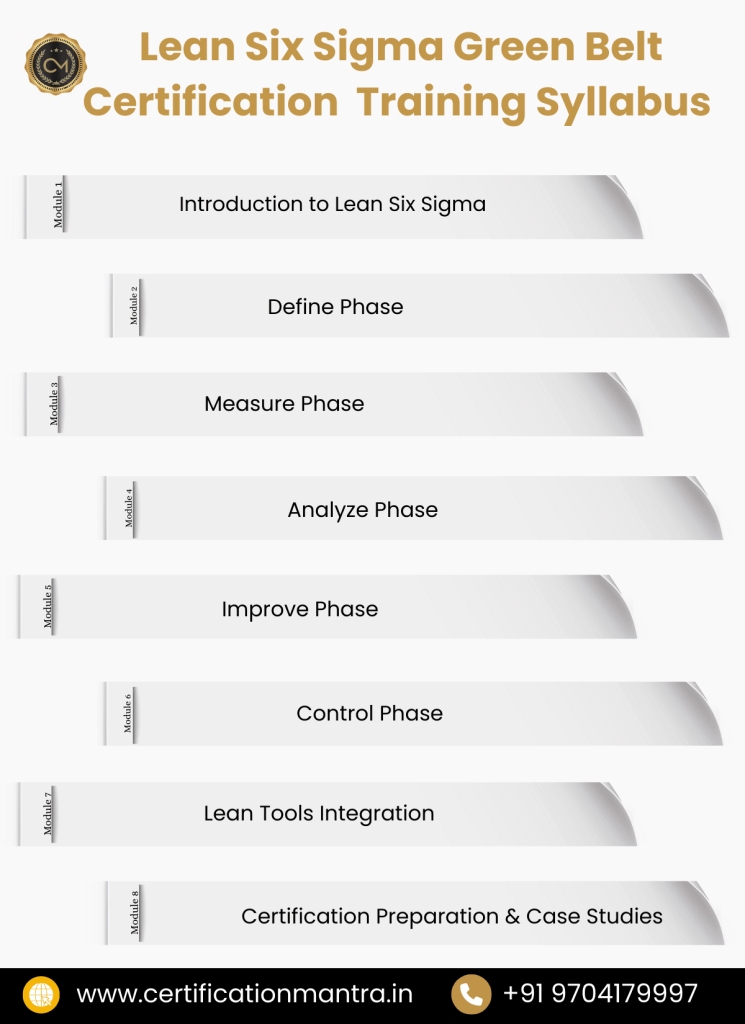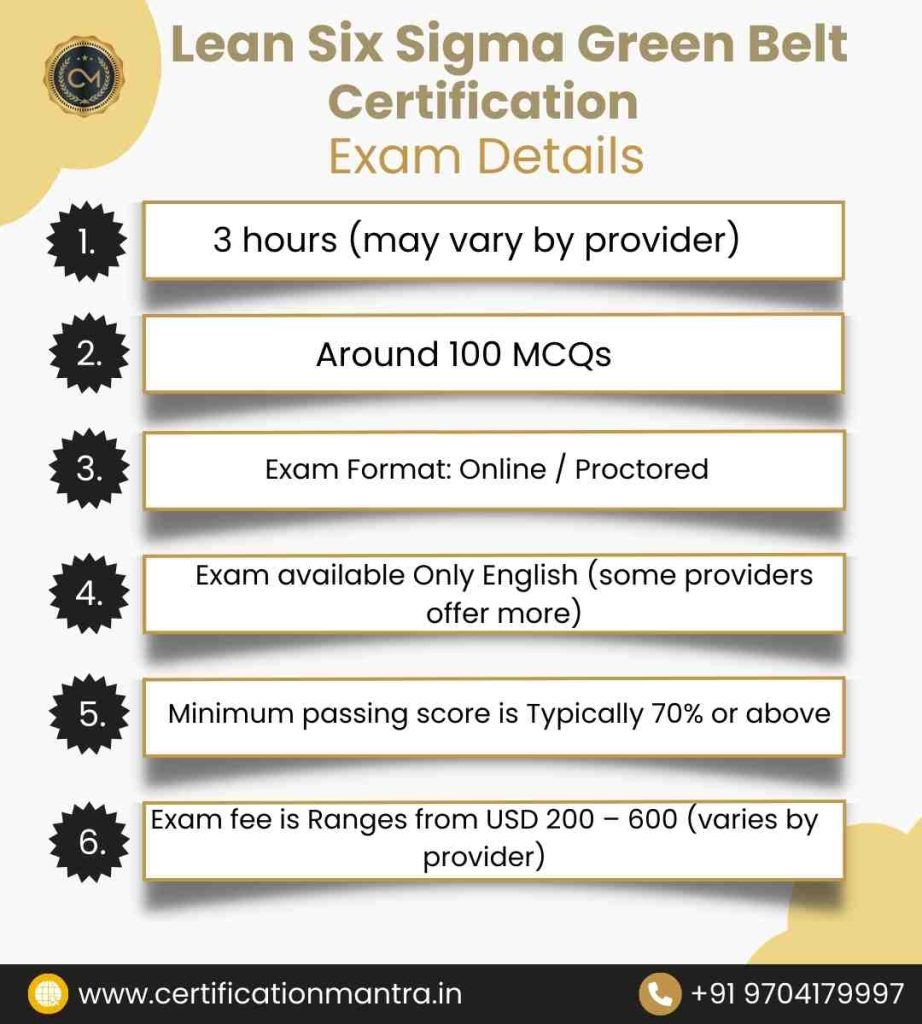Frequently Asked Questions

The Lean Six Sigma Green Belt Certification is a professional credential that proves you can improve business processes using Lean and Six Sigma tools. It focuses on reducing waste, improving efficiency, and solving problems systematically. The training teaches you the DMAIC (Define, Measure, Analyze, Improve, Control) methodology. It’s recognized worldwide and valued across multiple industries.
It’s ideal for professionals who want to lead or support process improvement projects. This includes team leaders, project managers, quality analysts, engineers, and operations staff. Even fresh graduates can take it to add value to their resume. If you want to solve problems and improve efficiency, this course is for you.
No strict prerequisites are required. Having a basic understanding of business processes is helpful but not mandatory. Some work experience in quality or process management is an advantage. Familiarity with basic statistics can make learning easier. Most importantly, you should be ready to learn and apply improvement techniques.
On average, it takes 2 to 4 weeks of training to complete, depending on the provider and learning mode. If it’s an intensive program, it may be finished in a week. Online self-paced courses might take longer. You’ll also need time to prepare for and take the exam.
The course covers the Lean Six Sigma fundamentals, DMAIC methodology, process mapping, data collection, root cause analysis, statistical tools, and improvement strategies. You’ll also get to learn Lean tools such as 5S, Kaizen, and Value Stream Mapping. The training includes case studies to apply what you’ve learned.
DMAIC stands for Define, Measure, Analyze, Improve, and Control, and it serves as the fundamental problem-solving framework in Six Sigma. Each phase has specific tools and techniques to improve processes. You start by defining the problem and end with controlling the new, improved process.
Yes, Lean Six Sigma is a globally recognized methodology, and Green Belt Certification is valued across industries worldwide. It can help you work in different countries or with international teams. Many multinational organizations are constantly in search of certified professionals.
The cost varies depending on the provider and location, but it usually ranges from $200 to $800 for online courses and can be higher for classroom training. Some organizations also cover the cost for employees. Always compare inclusions like training material, exam fees, and project support.
While no certification can guarantee a job, Green Belt significantly improves your chances. It provides you with highly sought-after skills that employers appreciate. Combined with your work experience, it can lead to better job opportunities, promotions, or salary hikes.
It’s challenging but manageable if you prepare well. The questions are designed to test your understanding of Lean Six Sigma concepts and problem-solving skills. Most people who complete the training and practice mock tests pass on their first attempt.
Industries like manufacturing, IT, healthcare, finance, supply chain, and consulting hire Green Belt professionals. Any business that relies on processes can benefit from Lean Six Sigma. Even service-based companies need process improvement experts.
Yes, you can directly enroll in Green Belt training without doing Yellow Belt first. The Green Belt course includes basic concepts, so beginners can still follow along.
Green Belts typically lead smaller projects and support larger ones, while Black Belts handle complex, high-impact projects and mentor others. Black Belt training is more in-depth and places strong emphasis on statistics and leadership skills.
The exam usually has multiple-choice questions covering all phases of DMAIC and Lean Six Sigma tools. Most tests are online, timed, and open-book, but this can vary. You need to score a set percentage (often around 70%) to pass.
Absolutely! Many providers offer online Green Belt courses that you can take from anywhere. You can choose live virtual classes or self-paced learning. Online courses are great for working professionals who need flexibility.
A Green Belt leads process improvement projects, collects and analyzes data, and works with teams to implement solutions. They connect management’s goals with day-to-day operational execution. Their role is both technical and leadership-oriented.
Validity depends on the certifying body. Some certifications are valid for life, while others require renewal every 3 to 5 years. Renewals may require completing a refresher course or providing proof of completed projects.
In many cases, yes. Tools like Minitab or Excel are commonly used for data analysis in Six Sigma. Some providers include software training as part of the course. Even basic Excel skills can be enough for simpler projects.
Most quality training providers include at least one real or simulated project. This enables you to put the concepts and tools you’ve learned into practice.. It’s also a great way to build experience for your resume.
You can, but it’s not recommended unless you already have strong process improvement experience. Green Belt builds a solid foundation and makes Black Belt concepts easier to understand.
Definitely. Employers value certified professionals because they bring proven problem-solving skills. Many companies actively prefer candidates with Lean Six Sigma credentials.
Yes! Many professionals complete the certification while working. Flexible schedules, evening classes, and online options make it manageable.
It’s used to identify problems, find their root causes, and fix them efficiently. Whether in manufacturing or a desk job, Lean Six Sigma tools help improve workflows.
Basic math and a little statistics are involved, but nothing too advanced. The training will teach you what you need to know.
Green Belt gives you both technical and leadership skills. It’s versatile and applicable in almost every industry, making it more universally useful than many niche certifications.
Some are lifetime certifications, others need renewal every few years. Always check with your training provider for exact details.
Yes, many Green Belt skills overlap with project management. This certification can strengthen your PM career path.
Training can be classroom-based, online live, or self-paced. Many providers use a mix of lectures, case studies, and practical exercises.
Absolutely! It’s one of the most recognized process improvement certifications and can pay off in career growth, salary, and skills.
Yes, students can enroll, especially if they want a head start in their careers. It looks great on a resume and can attract employers.
Some providers offer alumni networks, mentorship, and access to updated materials. Others may help with job placement or further certifications.
It varies by provider, but most require around 70% to pass. Always check the exam format before starting.
Yes, most providers allow retakes. Some offer free retakes within a certain period, while others charge a fee.







